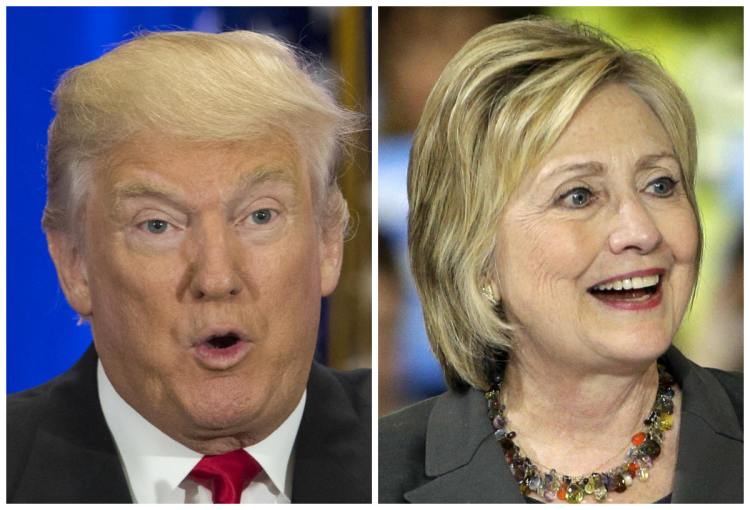WASHINGTON – For America’s wealthiest families, the presidential campaign presents a stark choice: A big tax increase if Hillary Clinton wins the election – or a big tax cut if Donald Trump wins.
For everyone else? Right now, neither candidate is proposing major tax changes.
Tax policy is probably where the two nominees differ the most. On trade, Clinton has backed off her previous support for free-trade agreements and, like Trump, now opposes the Trans-Pacific Partnership, a pact involving the U.S. and 11 other nations.
And Trump has said he will spend twice as much on building and repairing roads, airports and other infrastructure as Clinton would.
On trade and infrastructure spending, Trump has taken a populist approach that jettisons Republican orthodoxy. But on taxes, his proposed tax cuts for individuals and businesses are more in line with previous Republican candidates and elected officials.
Clinton, for her part, is proposing to raise taxes for the wealthiest households to pay for traditional Democratic proposals such as expanding access to higher education.
“Here, at least, they fall into very much traditional Democratic and Republican proposals,” said William Gale, co-director of the Tax Policy Center, a joint project of the Brookings Institution and Urban Institute.
Yet on taxes, the two candidates remain far apart. Here are summaries of their proposals:
TAXES ON HIGHER INCOMES
TRUMP: He would cut the top income tax bracket to 33 percent from its current level of 39.6 percent. Republican House Speaker Paul Ryan has made the same proposal, which the conservative Tax Foundation said would help boost after-tax income for the wealthiest 1 percent of Americans by 5.3 percent. Trump updated his tax proposal in a speech last week in Detroit, and hasn’t yet released many details. Tax experts haven’t been able to evaluate his proposals as a result.
CLINTON: She is proposing several tax increases on wealthier Americans, including a 4 percent surcharge on incomes above $5 million, effectively creating a new top bracket of 43.6 percent. And those earning more than $1 million a year would be subject to a minimum 30 percent tax rate. She would also cap the value of many tax deductions for wealthier taxpayers. All the changes would increase taxes in 2017 for the richest 1 percent by $78,284, reducing their after-tax income by 5 percent, according to the Tax Policy Center.
TAXES ON MIDDLE INCOMES
TRUMP: Would reduce the seven tax brackets in current law to three, at 12 percent, 25 percent and 33 percent. Using the Tax Foundation’s evaluation of the House Republican plan, which includes the same brackets, the change would lift after-tax incomes for the bottom 80 percent of income earners – those earning less than about $195,000 a year – by just 0.2 percent to 0.5 percent.
CLINTON: Says she will not raise taxes on the middle class. Her current proposals would have little impact on the bottom 95 percent of taxpayers, according to the Tax Policy Center.
CORPORATE TAX RATE
TRUMP: Would cut the corporate rate from its current 35 percent to 15 percent. He would also cut taxes on “pass-through” business income from partnerships such as law firms to 15 percent. More than two-thirds of “pass-through” income flows to the richest 1 percent of taxpayers, according to the liberal Center on Budget and Policy Priorities.
CLINTON: Would not change the corporate tax rate.
‘CARRIED INTEREST’ LOOPHOLE
TRUMP: Managers for private equity firms and hedge funds can classify their investment profits as “carried interest” and pay capital gains taxes on their income at rates that can be as low as half the regular income tax rate. Trump says he would eliminate the loophole, but hedge fund and private equity managers would be able to pay even lower tax rates under his proposal to cut business taxes to just 15 percent.
CLINTON: Would eliminate the loophole and tax carried interest as ordinary income.
ESTATE TAXES
TRUMP: Would eliminate the so-called “death tax” that is currently levied on estates worth more than $5.45 million ($10.9 million for married couples).
CLINTON: Would increase the estate tax to 45 percent from 40 percent and apply it to more estates, starting with those worth $3.5 million ($7 million for married couples).
CORPORATE INVERSIONS
TRUMP: Says his steep cut in the corporate tax rate would end the practice of corporate “inversions,” which occur when a U.S. company acquires a foreign corporation, then relocates overseas, to avoid paying U.S. corporate taxes. The U.S. corporate tax rate of 35 percent is the highest in the developed world, though many companies use deductions and other strategies to avoid paying that amount.
CLINTON: Would discourage inversions by making it harder for a U.S. company to classify itself as a foreign-owned to avoid U.S. taxation. She would also place an “exit tax” on companies that leave the U.S. while still keeping earnings overseas that haven’t been subject to U.S. tax.
CHILD CARE
TRUMP: Wants to make all child care costs tax-deductible. Would allow the deduction to apply to Social Security and Medicare taxes to benefit lower-income earners who pay little or no income tax. Current law allows parents to deduct up to $6,000 in child care expenses.
CLINTON: Has made several proposals intended to help limit child care expenses to 10 percent of a family’s income, but hasn’t proposed using the tax code to achieve that goal.
SOCIAL SECURITY
TRUMP: Would allow taxpayers to deduct child care costs from Social Security and Medicare taxes.
CLINTON: Says she will ask the wealthiest to “contribute more” to Social Security, by raising the cap on income currently subject to Social Security taxes, but has not released any details.
Send questions/comments to the editors.


